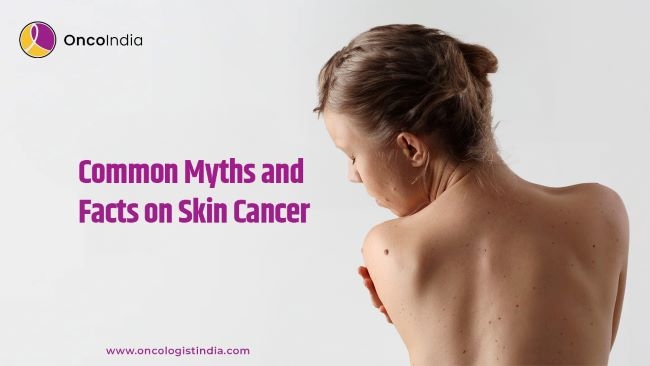Common Myths and Facts on Skin Cancer
Skin cancer is a prevalent yet often misunderstood condition. No matter your skin colour, anyone can be affected by skin cancer. It is also one of the most preventable forms of cancer. The root cause of skin cancer is said to be excess sun exposure and tanning. There are many misconceptions about skin cancer which need to be addressed.
It's crucial to separate fact from fiction to promote awareness and effective prevention. In this blog, we'll debunk some common skin cancer myths and shed light on the facts everyone should know.

Myth 1: Skin cancer does not affect those with darker skin.
Let’s break the biggest myth of all, which is in terms of skin complexion.
No matter your race or skin tone, you can still get skin cancer from UV exposure.
Studies have shown that people with darker skin are more likely to have skin cancer, making early detection crucial for everyone. Darker-skinned individuals are over three times as likely to be diagnosed with melanoma at a late stage compared to white patients.
It’s important to note that not all skin cancer in darker-skinned people is solely linked to UV damage. There are rare subtypes, like acral lentiginous melanoma, which appear in areas like the palms, soles, and nail beds. These types are more common in communities of colour.
Myth 2: To acquire Vitamin D, I have to spend time in the sun.
As a matter of fact, sun exposure does give Vitamin D as it contributes to bone health and aids in the body's absorption of calcium. But do you have to get yourselves baked in the sun for that? No! You can actually get plenty of nutrients through everyday exposure and from the foods you eat. This avoids the extra risk of skin cancer from too much sun exposure.
Myth 3: Skin Cancer Is Only Caused by UV Exposure
UV exposure is not only the root cause of skin cancer, there's more to it.
Family history can also play a role. While the specific genes behind melanoma aren't fully understood, there are indications of their involvement. This is particularly relevant for teenagers and younger adults with a family history of skin cancer.
Certain rare types of skin cancer, such as those affecting the eyes, mucosa, and areas like the palms and soles of the feet, aren't typically linked to UV exposure. Additionally, having numerous moles or certain types of moles can heighten the risk of skin cancer, as noted by the Centers for Disease Control and Prevention (CDC).
Plus, having lots of moles, especially certain kinds, can raise your risk of skin cancer, says the CDC.
Myth 4: Skin Cancer Isn’t a Serious Health Condition
Skin cancer, especially melanoma, can be fatal if not detected early. Melanoma tends to spread to other parts of the body. If diagnosed beyond stage 1, surgery and immunotherapy are usually necessary.
Immunotherapy, a treatment that trains the immune system to fight cancer cells, was one of the earliest FDA-approved treatments for leukaemia and melanoma. Unlike chemotherapy, which uses toxic agents to kill tumour cells, immunotherapy works by harnessing the body's immune response.
For certain basal and squamous cell skin cancers, radiation therapy may be required after surgery to eliminate any remaining tumour cells, as advised by the American Cancer Society.
Myth 5: The greater the SPF of a sunscreen, the better
The SPF number on sunscreen only linearly increases protection. For instance, SPF 30 blocks 97% of UV rays, SPF 50 slightly more at 98%, and SPF 100 at 99%. So, SPF 30 is a good choice.
Even with higher SPF, protection isn't perfect, especially if sunscreen isn't applied enough or reapplied. It's best to avoid the sun, especially between 10 a.m. and 4 p.m., and wear protective clothing outside.
Treatment for Skin Cancer
The preferred treatment typically involves a surgical procedure known as Mohs microscopic surgery. Unlike normal surgeries for cancer that require removing a minimum 1 cm margin of tissue, Mohs surgery is more precise and particularly crucial for delicate areas like the face and eyes where wide margins aren't feasible. Dr. Shiva Kumar, a Surgical Oncologist at Trust-in Hospital, explains that Mohs surgery is the method of choice in such cases.
Mohs surgery is a precise technique for removing high-risk skin cancer. Here's how it works:
The surgeon cuts away the tumour in layers, starting with the visible part and a margin of surrounding skin cells.
Each layer is examined under a microscope to check for cancer cells at the edges.
If cancer cells are found at any edge, more tissue is removed.
This process repeats until all cancerous cells are removed.
It ensures thorough removal while preserving as much healthy tissue as possible.
Dr. Shiva Kumar further added that Mohs microscopic surgery entails testing extremely thin sections of the tumour during the procedure, continuing until the pathology report confirms negativity. This real-time analysis by the pathologist ensures the preservation of critical nearby structures while achieving good oncological results. Additionally, advanced chemotherapy and radiation therapy may be employed to further treat skin cancer.
In the treatment of Malignant melanoma, significant advancements have been made. Initially, surgery remains a cornerstone, followed by a range of chemotherapy options. However, the field has seen substantial progress in immunotherapy, which is increasingly recognized as highly effective against Malignant melanoma.
Conclusion
Uncovering the misconceptions and learning the facts can empower ourselves and others to take proactive steps in prevention, early detection, and treatment. Remember to protect your skin, understand risk factors, and prioritise regular skin checks with a dermatologist to stay vigilant against this prevalent disease. After all, your skin health matters.
Blog Reviewed By: Dr. Shiva Kumar Uppala